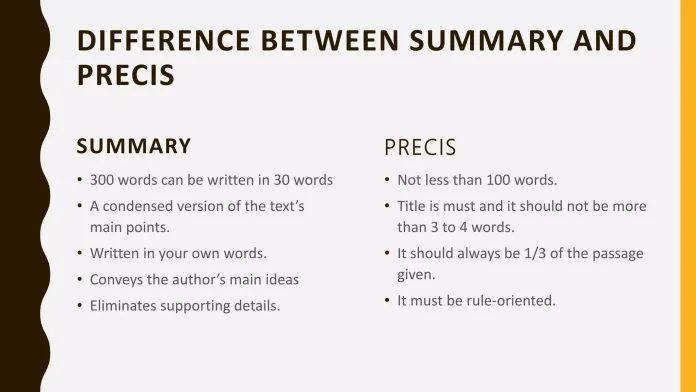Precis vs Summary: Key Differences, Uses, and Writing Tips
Both a precis and a summary are handy tools for condensing content, but they’re not interchangeable. While both aim to shorten texts, they have distinct purposes and adhere to different writing conventions. Understanding the difference between a precis and a summary can enhance your writing, studying, and communication skills. Let’s dive into what makes them unique, when to use each one, and how to craft them effectively.
What Is a Precis?
A precis is a brief restatement of a passage or speech, expressed in your own words. It retains the original tone, structure, and key points while eliminating examples and repetition. Typically, a precis is about one-third the length of the original text. It emphasizes clarity, coherence, and accuracy, capturing the writer’s intent without adding personal opinions or unnecessary details. You’ll often find precis used in academic and professional contexts where precision is key.
What Is a Summary?
A summary provides a broader overview of the main ideas in a text. Unlike a precis, it doesn’t necessarily stick to the original structure. A summary simplifies and clarifies key points, omitting minor details and a formal tone. Depending on its purpose, a summary can be shorter or longer than a precis. Summaries are commonly used in education, media, and everyday conversations to offer a quick grasp of the content.
Key Differences Between a Precis and a Summary:
While a precis and a summary might seem alike, they actually have distinct focuses and formats. A precis demands a deeper grasp of the text’s structure and tone, capturing the writer’s presentation of ideas. In contrast, a summary simply highlights what the writer conveys, often without sticking to the original format. A precis tends to be more formal and precise, whereas a summary offers more leeway and simplification. Both forms steer clear of personal opinions but cater to different needs.
When to Use a Precis or a Summary:
Opt for a precis when you want to demonstrate a thorough understanding of style and structure. It’s particularly useful for academic analysis, reporting speeches, or crafting formal reports. On the other hand, a summary is your go-to when you need to quickly convey the essence of the content. It’s ideal for notes, reviews, and brief explanations. The choice between the two really hinges on your goal, audience, and the context of your writing task.
Tips for Writing a Good Precis:
To craft a solid precis, start by reading the original text with care. Pinpoint the main idea, tone, and supporting points. Paraphrase in your own words while keeping the author’s message intact. Steer clear of repetition, examples, and unnecessary details. Maintain objectivity and aim for about one-third the length of the original. Use clear, formal language and ensure a logical flow.
Tips for Writing an Effective Summary:
Begin by scanning the text for key ideas. Pay attention to headings, topic sentences, and conclusions. Simplify complex information without altering the meaning. Use straightforward language and organize your ideas logically. Keep it concise and to the point. Depending on your purpose, you can choose between bullet points or paragraphs.
Conclusion:
Although both precis and summary serve to condense information, they differ in tone, purpose, and structure. Grasping these differences enables you to select the appropriate form for any task. A precis is all about precision and formality, while a summary is more flexible and quick. Mastering both skills can enhance your writing, reading, and communication across all areas of life.

